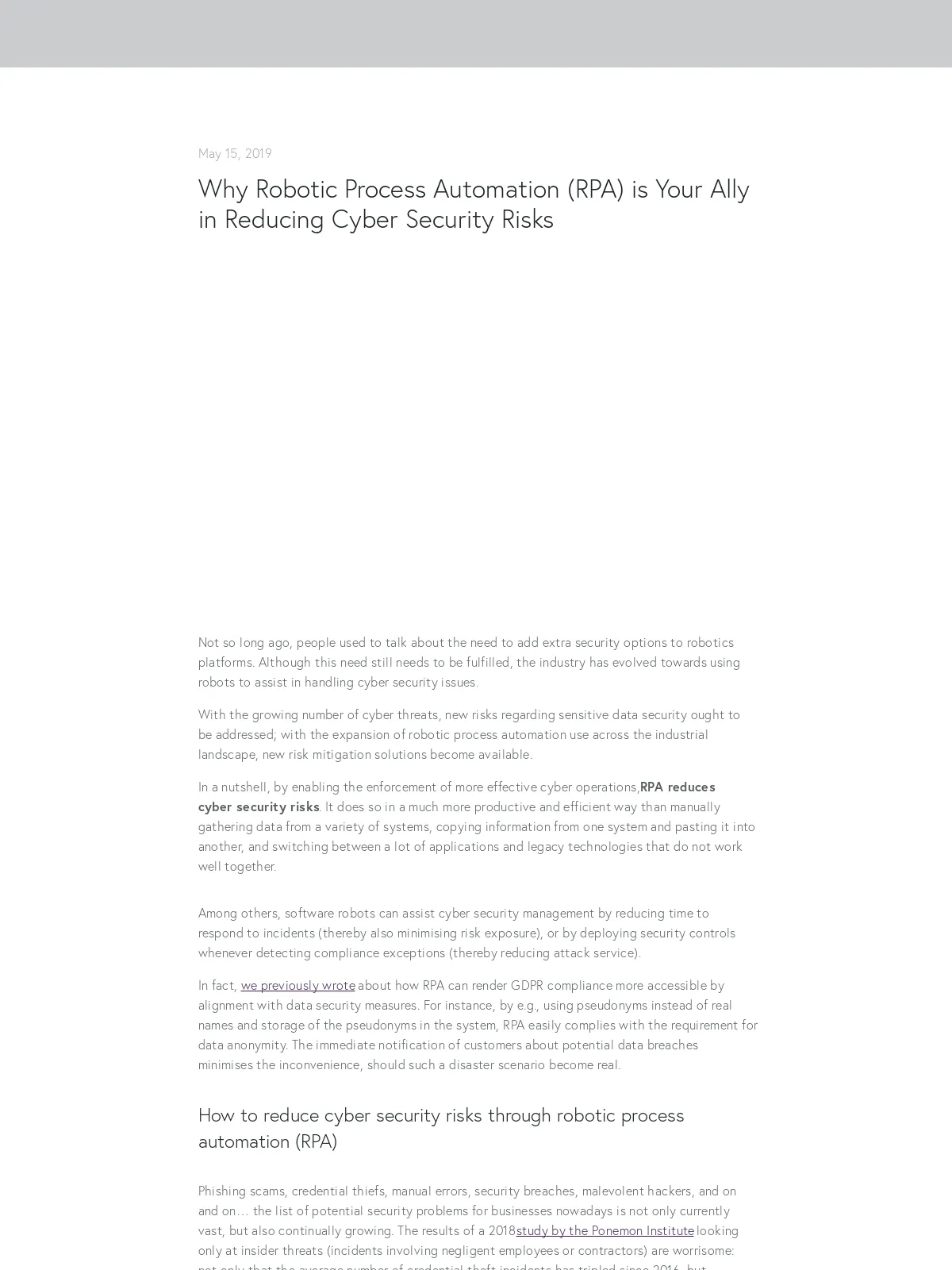Why Robotic Process Automation (RPA) is Your Ally in Reducing Cyber Security Risks
Blog: Cigen

Not so long ago, people used to talk about the need to add extra security options to robotics platforms. Although this need still needs to be fulfilled, the industry has evolved towards using robots to assist in handling cyber security issues.
With the growing number of cyber threats, new risks regarding sensitive data security ought to be addressed; with the expansion of robotic process automation use across the industrial landscape, new risk mitigation solutions become available.
In a nutshell, by enabling the enforcement of more effective cyber operations, RPA reduces cyber security risks. It does so in a much more productive and efficient way than manually gathering data from a variety of systems, copying information from one system and pasting it into another, and switching between a lot of applications and legacy technologies that do not work well together.
Among others, software robots can assist cyber security management by reducing time to respond to incidents (thereby also minimising risk exposure), or by deploying security controls whenever detecting compliance exceptions (thereby reducing attack service).
In fact, we previously wrote about how RPA can render GDPR compliance more accessible by alignment with data security measures. For instance, by e.g., using pseudonyms instead of real names and storage of the pseudonyms in the system, RPA easily complies with the requirement for data anonymity. The immediate notification of customers about potential data breaches minimises the inconvenience, should such a disaster scenario become real.
How to reduce cyber security risks through robotic process automation (RPA)
Phishing scams, credential thiefs, manual errors, security breaches, malevolent hackers, and on and on… the list of potential security problems for businesses nowadays is not only currently vast, but also continually growing. The results of a 2018 study by the Ponemon Institute looking only at insider threats (incidents involving negligent employees or contractors) are worrisome: not only that the average number of credential theft incidents has tripled since 2016, but containment of insider incidents takes on average two months and $283,281. So you’d better try to avoid those as much as possible.
But what are the underlying challenges for the protection of data filled environments, such as all financial organisations are? The biggest threat is human intervention, be it in the form of unintentional error (e.g., spreadsheet errors or mistakes in the management of privileged data, inadequate password hygiene, “honest errors” due to having to switch between many applications to complete a single task, etc.), or intentional malicious attacks.
Operational functions such as procure-to-pay, quote-to-cash, payroll automation, claims processing, insurance claims, etc., require employees to process sensitive data.
Data access as well as permission to update the information involve use of credentials to log into the system. More, the system interacts with other front-end and back-end systems like CRM and ERP, and the interaction calls for human intervention. This fact in and of itself is a risky premise, because it leaves open the possibility of privileged access abuse and data misuse. The good thing is that acknowledgment of this possibility drives the fast-paced development of strategies that enable the prevention of data breaches.
How can RPA reduce cyber security risks?
According to an EY report, there are three main ways that software robots can help alleviate threats across cybersecurity domains like digital identity and access, software and product security, data identification and protection, etc.:
Compensate for the anticipated shortage of cybersecurity professionals;
Considerably reduce the average time to detect threats;
Limit employee involvement in the management of personally identifiable information (PII).
The fact that all the activity of software bots is tracked and safely logged is an additional argument for the contribution of RPA to reduce cyber security risks, because it allows to avoid PII data meddling.
In order to better grasp these directions of robot assistance let us now zoom in on some examples of RPA security-related application areas.
1. Application inventory tracking
The discovery and inventory applications work in highly predictable, repetitive, rule based way, so they are perfect candidates for robotic process automation. Software robots can continuously monitor the inventory and update it whenever they discover risky areas. Risk classification can also be automated by applying cognitive learning to previously detected data.
Thank you! An expert will get in touch soon.
2. Access certification
Because of their rule based nature, all subprocesses of certification are open to automation. Replacing manual validation checks of precertification data, campaign checks during access certifications and reviews, certification configuration management, as well as post certification reconciliation and reporting with automated processing diminishes unauthorized access and PII data looting. The outcome is an increase in the operational and cost efficiency gains by up to 45%.
3. Access data validation
Leveraging RPA can boost the efficiency of checking the suitability of access data. Consequently, during the review process managers are freed to focus on higher-risk access concerns, e.g., malicious attacks. Whenever bots notice inconsistencies while validating access data, they can also be trained to promptly inform users by email.
4. Data classification and remediation
Robots can be deployed to detect sensitive data, and either validate it or remove it if stored in unauthorized locations. Cognitive learning can refine the automated processing by categorising confidential information.
5. Threat detection and remediation
Another way in which robotic process automation reduces cyber security risks is by capturing threat intelligence. If an antivirus system alert is encountered, bots can prevent the actual intrusions and/ or the spread of viruses across the business computer network.
By running a fast-paced analysis of the encountered malware alerts, bots are able to select the most relevant information bits and, based on this, make response decisions as to when and how to address the threats. For instance, detected hostile users’ data access can be remotely disabled or locked via email or SMS.
Conclusion
Security risks are among the most ardent problems in the rapidly evolving technological global context. Risk prevention by means of robotic process automation allows the reduction of data tampering by human error as well as malevolent cyber behaviour.
Choosing a stable RPA tool (here you can find some suggestions for finding the optimal RPA tool for your business), and constantly monitoring the security measures (e.g., audit logs, data encryption, resource- and role-based access control to confidential data, etc.) are mandatory steps to mitigate the cyber security risks. Additionally, by leveraging robotic process automation as your ally to this end, you also increase consistent compliance to business norms.
